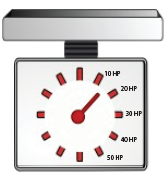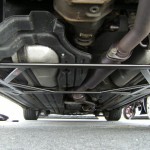Most enthusiasts are aware that lowering a car's center of gravity is good for handling and indeed, grip.
It's easy to see the real world implications as well when we think about how a tall SUV handles versus a very low Ferrari or Corvette.
Where the Center of Gravity Is
The car's center of gravity has both a horizontal (x, y) and vertical (z) location and actually refers to a single point where if suspended, the car would balance perfectly (at least in theory).
So vertically, we already know that the lower the center of gravity - the better. What about horizontally? Well, again, take a look at super cars - the closer weight is to the center of the vehicle the better. This is why super cars are typically mid-engine, so the heaviest part of the car (the engine/transmission) is closer to the middle of the vehicle.
The center of gravity in most cars is roughly at the top of the front bumper in terms of height (just a very rough estimate). The (x,y) coordinate of the center of gravity is much more variable, the Y being affected by the car's front and rear weight distribution. So in most cases, the CoG is at bumper height, somewhere in front of the midline of the car as you look at it from the side of the car. As you look from the front of the car, it is going to be either in the driver or the passenger's lap as most cars are slightly heavier on one side or the other.
Improving Center of Gravity - Vertically
Lowering a car is one way to improve the vertical center of gravity. This will offer increased stability, lessen the risk of roll over in extreme situations, and in most cases increase lateral grip (or the "g" handling figures on the skid pad). There are practical limits on how low you can go due to road imperfections and so on. There are also limits on how low you can go on a factory suspension without actually hurting handling. Usually around an inch of lowering is the farthest you can go without serious changes to your suspension geometry... but more on that in another article.
Vertical CoG can be improved by removing weight or choosing not to locate weight high in the vehicle. You can also get a CoG advantage from choosing a vehicle without a sunroof. Sunroofs in modern cars are around 25-30lbs, but in older vehicles they were sometimes 40-60lbs. In any case, take note that BMW thought it worth the exceptional expense to use a carbon fiber roof on many of their M vehicles. A few pounds on the roof of a vehicle can make a significant difference on the track, and 10-15 lbs can make a noticeable difference even on mountain roads.Having removed the sunroof on a car before, I can say that removal is not ideal (reasonably expensive) and you'll be better off to start with a car without a sunroof if possible.
Continue reading →
 John also earns the distinction of being recognized as one of the Tuner University Certified Experts and the first to receive the honor. This honor is one given only to companies and individuals who have earned their stripes and demonstrated unique abilities and innovations in motorsport, OEM, and aftermarket parts/services.
John also earns the distinction of being recognized as one of the Tuner University Certified Experts and the first to receive the honor. This honor is one given only to companies and individuals who have earned their stripes and demonstrated unique abilities and innovations in motorsport, OEM, and aftermarket parts/services.
 Have you ever wondered what 10 or 20 extra horsepower might "feel" like in your car?
Have you ever wondered what 10 or 20 extra horsepower might "feel" like in your car? to supposedly improve handling. People shell out hundreds, even thousands of dollars on strut bars, under body braces, suspension member braces, fender braces, and frankly braces that attach to just about anything that has a bolt in it.
to supposedly improve handling. People shell out hundreds, even thousands of dollars on strut bars, under body braces, suspension member braces, fender braces, and frankly braces that attach to just about anything that has a bolt in it.